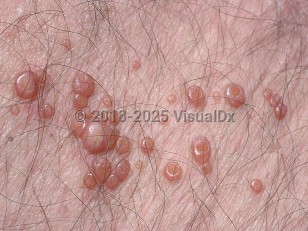Molluscum contagiosum
See also in: External and Internal Eye,AnogenitalAlerts and Notices
Important News & Links
Synopsis

Molluscum contagiosum is a viral skin infection caused by a DNA poxvirus. It manifests as smooth, firm papules with central umbilication. Molluscum contagiosum may be spread by direct skin-skin contact (most often in children), via fomites (eg, towel, gym equipment), via autoinoculation, or via sexual transmission in adults.
In adults, molluscum contagiosum is commonly found on the mons pubis, the genitalia, perineum, inner thighs, and lower abdomen. The distribution in children is on the trunk and extremities. In underlying immunodeficiency, such as HIV disease, molluscum may be widespread or large, atypical papules and/or plaques may be seen.
Many cases are asymptomatic, but there can be surrounding irritation and pruritus.
In the immunocompetent host, the disease tends to be self-limited, but papules may persist for several months and up to 2 years before disappearing.
Immunosuppressed patients and those with HIV disease / AIDS are at particular risk of molluscum contagiosum infection, with a prevalence of 5%-18%. The number of lesions is inversely correlated with the CD4 count, and the presence of molluscum contagiosum lesions can actually indicate an AIDS diagnosis. Molluscum contagiosum has also been reported in association with several other immunosuppressed states including malignancies, severe combined immunodeficiency, organ and bone marrow transplants, and chemotherapy recipients. Sarcoidosis and atopic dermatitis also predispose patients to molluscum contagiosum infections, most likely due to abnormal T-cell immunity.
Codes
B08.1 – Molluscum contagiosum
SNOMEDCT:
40070004 – Molluscum contagiosum
Look For
Subscription Required
Diagnostic Pearls
Subscription Required
Differential Diagnosis & Pitfalls

Subscription Required
Best Tests
Subscription Required
Management Pearls
Subscription Required
Therapy
Subscription Required
Drug Reaction Data
Subscription Required
References
Subscription Required
Last Updated:05/05/2021
 Patient Information for Molluscum contagiosum
Patient Information for Molluscum contagiosum - Improve treatment compliance
- Reduce after-hours questions
- Increase patient engagement and satisfaction
- Written in clear, easy-to-understand language. No confusing jargon.
- Available in English and Spanish
- Print out or email directly to your patient


